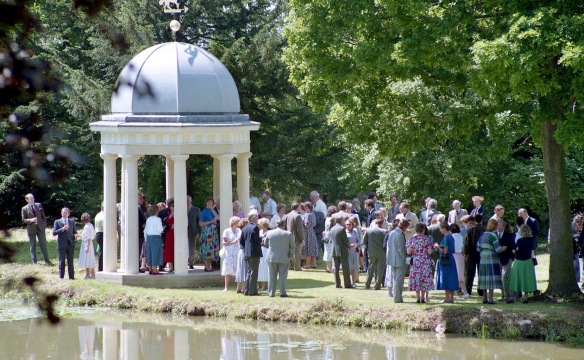CLICK ON IMAGES TO ENLARGE. REPEAT IF NECESSARY.
Another day of incessant rain led me to drafting the next section of my biography. I took some of the text from my posts ‘Holly’ and ‘Dunkirk’.
Since I am writing about the several eras of one man’s life, I have begun with what life was like in 1942. Since my blog has been about my own memories, and I don’t have any for the year of my birth, I have applied my knowledge of history and a little research. The draft itself will not appear in my posts. After all, the idea is that people don’t read it before it is finished.
Later, I scanned another batch of colour negatives, from June and July 1990.
That June, our aptly named young neighbour, James Bird, came across a family of coots that had suffered a road accident. Just one scrawny little chick survived. James knew we had a small pond, so he brought the baby bird to Jessica to care for. She did a good enough job for the creature to disappear after a few weeks. This made her rather sad. The Newark Advertiser printed an article, vainly seeking the return of the pet.
The following month we attended the grand opening of Edmund Staunton’s temple. This structure built by the gentleman farmer on his land at Staunton Manor maintains a long tradition of architectural structures, known as follies. Another I have featured on occasion is ‘Peterson’s Folly’, known as Sway Tower. Wikipedia has this to say about the genre:
‘In architecture, a folly is a building constructed primarily for decoration, but suggesting through its appearance some other purpose, or of such extravagant appearance that it transcends the range of garden ornaments usually associated with the class of buildings to which it belongs.
18th century English gardens and French landscape gardening often featured mock Roman temples, symbolising classical virtues. Other 18th century garden follies represented Chinese temples, Egyptian pyramids, ruined abbeys, or Tatar tents, to represent different continents or historical eras. Sometimes they represented rustic villages, mills, and cottages to symbolise rural virtues.[1]Many follies, particularly during times of famine, such as the Irish potato famine, were built as a form of poor relief, to provide employment for peasants and unemployed artisans.
In English, the term began as “a popular name for any costly structure considered to have shown folly in the builder”, the OED‘s definition,[2] and were often named after the individual who commissioned or designed the project. The connotations of silliness or madness in this definition is in accord with the general meaning of the French word “folie”; however, another older meaning of this word is “delight” or “favourite abode”[3] This sense included conventional, practical, buildings that were thought unduly large or expensive, such as Beckford’s Folly, an extremely expensive early Gothic Revival country house that collapsed under the weight of its tower in 1825, 12 years after completion. As a general term, “folly” is usually applied to a small building that appears to have no practical purpose, or the purpose of which appears less important than its striking and unusual design, but the term is ultimately subjective, so a precise definition is not possible.’
Helen and Bill visited for a pleasant couple of hours conversation, and departed with two trays of potted cuttings Jackie has prepared for their church sale.
We dined this evening on fish pie, cauliflower, and green beans, with which we both drank Wairau Cove Sauvignon Blanc 2016.







